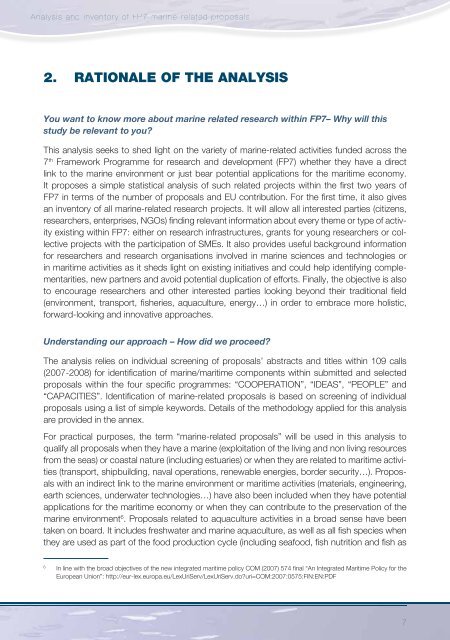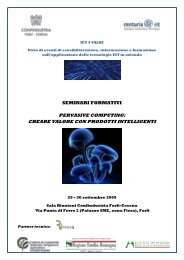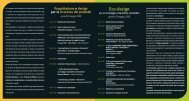Analysis and inventory of FP7 marine-related proposals - European ...
Analysis and inventory of FP7 marine-related proposals - European ...
Analysis and inventory of FP7 marine-related proposals - European ...
Create successful ePaper yourself
Turn your PDF publications into a flip-book with our unique Google optimized e-Paper software.
<strong>Analysis</strong> <strong>and</strong><strong>inventory</strong> <strong>of</strong> <strong>FP7</strong> <strong>marine</strong>-<strong>related</strong> ed <strong>proposals</strong>posa2. RATIONALE OF THE ANALYSISYou want to know more about <strong>marine</strong> <strong>related</strong> research within <strong>FP7</strong> – Why will thisstudy be relevant to you?This analysis seeks to shed light on the variety <strong>of</strong> <strong>marine</strong>-<strong>related</strong> activities funded across the7 th Framework Programme for research <strong>and</strong> development (<strong>FP7</strong>) whether they have a directlink to the <strong>marine</strong> environment or just bear potential applications for the maritime economy.It proposes a simple statistical analysis <strong>of</strong> such <strong>related</strong> projects within the fi rst two years <strong>of</strong><strong>FP7</strong> in terms <strong>of</strong> the number <strong>of</strong> <strong>proposals</strong> <strong>and</strong> EU contribution. For the fi rst time, it also givesan <strong>inventory</strong> <strong>of</strong> all <strong>marine</strong>-<strong>related</strong> research projects. It will allow all interested parties (citizens,researchers, enterprises, NGOs) fi nding relevant information about every theme or type <strong>of</strong> activityexisting within <strong>FP7</strong>: either on research infrastructures, grants for young researchers or collectiveprojects with the participation <strong>of</strong> SMEs. It also provides useful background informationfor researchers <strong>and</strong> research organisations involved in <strong>marine</strong> sciences <strong>and</strong> technologies orin maritime activities as it sheds light on existing initiatives <strong>and</strong> could help identifying complementarities,new partners <strong>and</strong> avoid potential duplication <strong>of</strong> efforts. Finally, the objective is alsoto encourage researchers <strong>and</strong> other interested parties looking beyond their traditional fi eld(environment, transport, fi sheries, aquaculture, energy…) in order to embrace more holistic,forward-looking <strong>and</strong> innovative approaches.Underst<strong>and</strong>ing our approach – How did we proceed?The analysis relies on individual screening <strong>of</strong> <strong>proposals</strong>’ abstracts <strong>and</strong> titles within 109 calls(2007-2008) for identifi cation <strong>of</strong> <strong>marine</strong>/maritime components within submitted <strong>and</strong> selected<strong>proposals</strong> within the four specifi c programmes: “COOPERATION”, “IDEAS”, “PEOPLE” <strong>and</strong>“CAPACITIES”. Identifi cation <strong>of</strong> <strong>marine</strong>-<strong>related</strong> <strong>proposals</strong> is based on screening <strong>of</strong> individual<strong>proposals</strong> using a list <strong>of</strong> simple keywords. Details <strong>of</strong> the methodology applied for this analysisare provided in the annex.For practical purposes, the term “<strong>marine</strong>-<strong>related</strong> <strong>proposals</strong>” will be used in this analysis toqualify all <strong>proposals</strong> when they have a <strong>marine</strong> (exploitation <strong>of</strong> the living <strong>and</strong> non living resourcesfrom the seas) or coastal nature (including estuaries) or when they are <strong>related</strong> to maritime activities(transport, shipbuilding, naval operations, renewable energies, border security…). Proposalswith an indirect link to the <strong>marine</strong> environment or maritime activities (materials, engineering,earth sciences, underwater technologies…) have also been included when they have potentialapplications for the maritime economy or when they can contribute to the preservation <strong>of</strong> the<strong>marine</strong> environment 6 . Proposals <strong>related</strong> to aquaculture activities in a broad sense have beentaken on board. It includes freshwater <strong>and</strong> <strong>marine</strong> aquaculture, as well as all fi sh species whenthey are used as part <strong>of</strong> the food production cycle (including seafood, fi sh nutrition <strong>and</strong> fi sh as6In line with the broad objectives <strong>of</strong> the new integrated maritime policy COM (2007) 574 fi nal “An Integrated Maritime Policy for the<strong>European</strong> Union”: http://eur-lex.europa.eu/LexUriServ/LexUriServ.do?uri=COM:2007:0575:FIN:EN:PDF7





